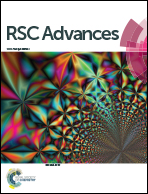Rapid assembly of quinazolinone scaffold via copper-catalyzed tandem reaction of 2-bromobenzamides with aldehydes and aqueous ammonia: application to the synthesis of the alkaloid tryptanthrin†
Abstract
An efficient and practical procedure for the preparation of 2-substituted and 2,3-disubstituted quinazolinones was achieved through copper-catalyzed tandem reaction of 2-bromobenzamides with aldehydes and aqueous ammonia under air. Control experimental results indicated that this tandem reaction is triggered by a copper-catalyzed direct amination of 2-bromobenzamides with aqueous ammonia, followed by cyclocondensation and oxidative aromatization. As an application, this novel methodology provides a concise and practical one-pot route to the synthesis of alkaloid tryptanthrin.


 Please wait while we load your content...
Please wait while we load your content...